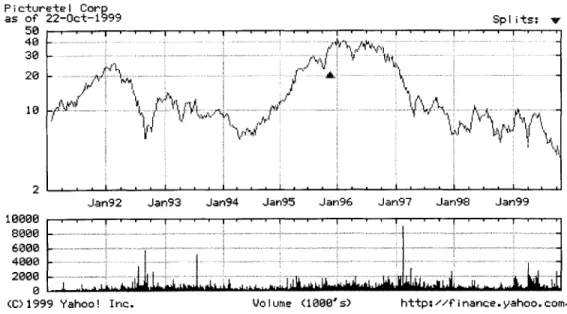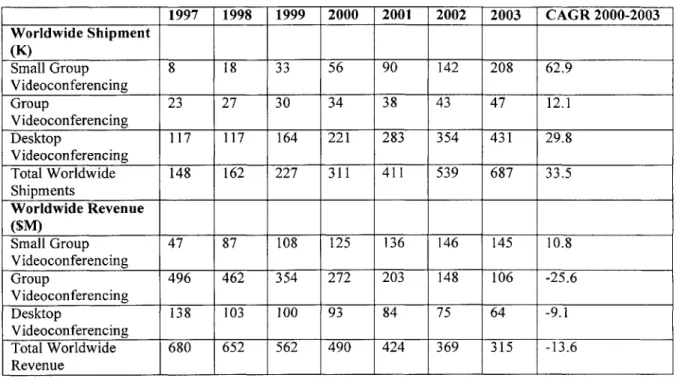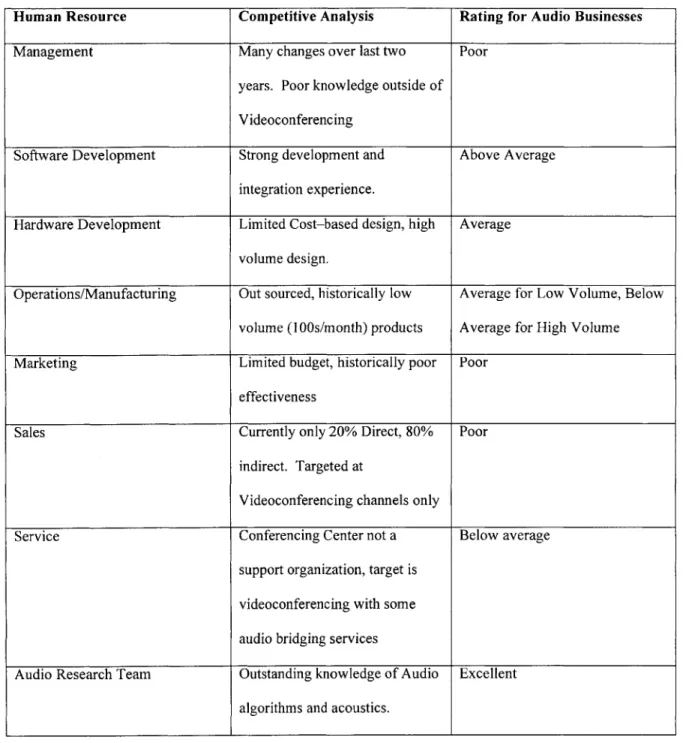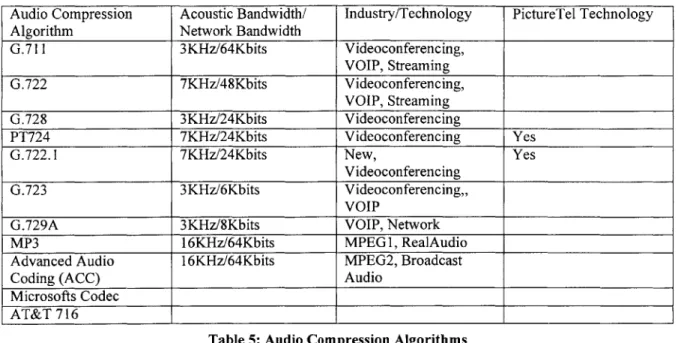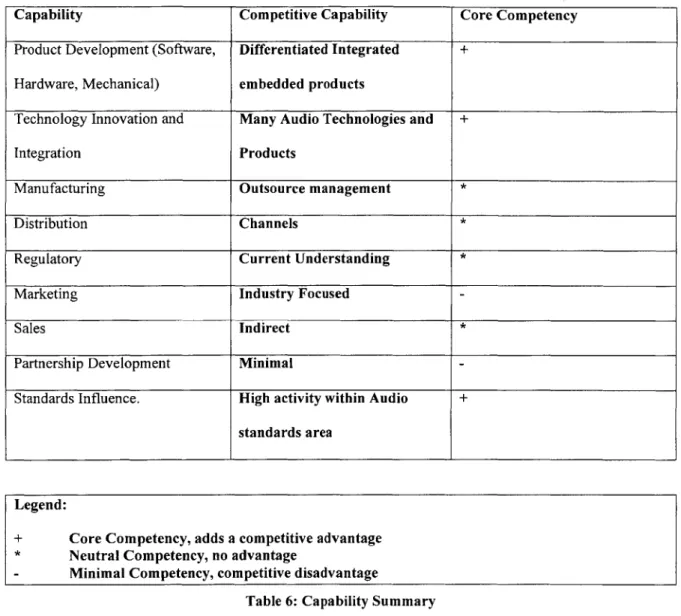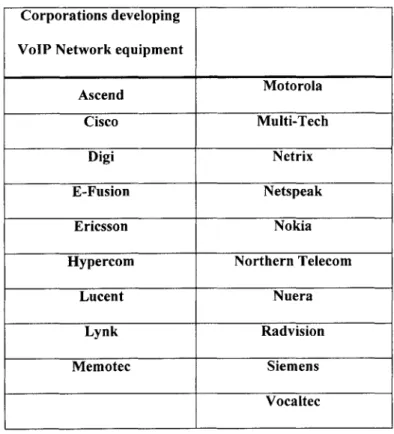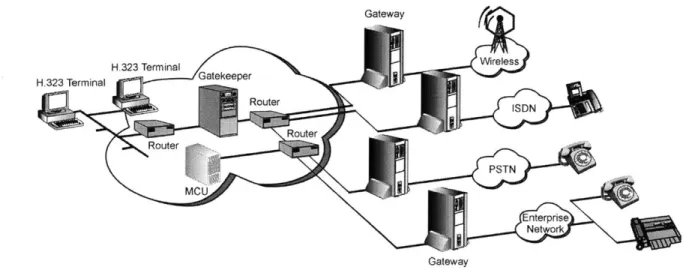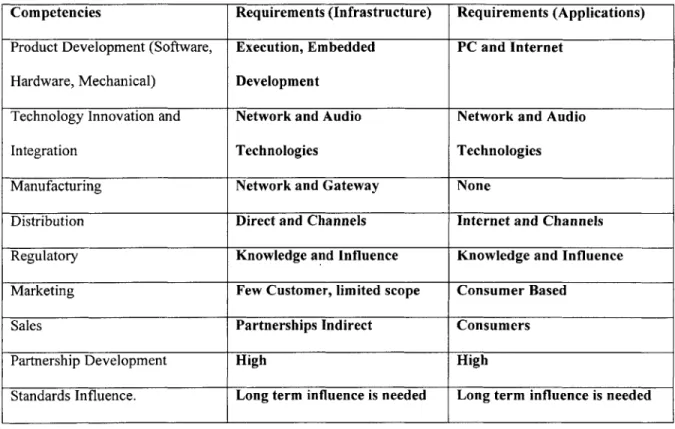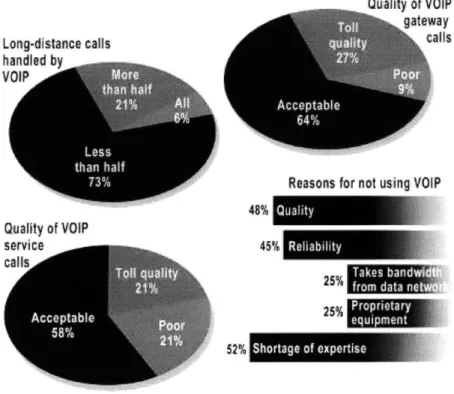Audio Communications Product Strategy for the
2 1
"t Century
By
Timothy D. Root
B.S., Electrical Engineering, Northeastern University (1989)
M.S., Electrical Engineering, Worcester Polytechnic Institute (1991)
Submitted to the
Department of System Design and Management
in Partial Fulfillment of the Requirements for the Degree of
Master of Science in Engineering and Management (2000)
At the
Massachusetts Institute of Technology
January 2000
VIUihe0ilsg*0o M '2000 Timothy Root. All rights reserved
perm
rePrOducnd to
dsibute pub:4ct? poper ad
/
electronIc copies of tt tMs
/
unent
In whofe or in rr.Signature of Author . . . .
Certified by . . . .
MASSACHUSETTS INSTITUTE OF TECHNOLOGYMAR 2 0 2001
LIBRARIES
Sy em Design and Management Program
January, 2000
LI
Accepted by . . . .
Accepted by . . . ..
Michael A. Cusumano
Sloan Distinguished Professor of Management
Thesis Supervisor
Dr. Thomas A. Kochan
George M. Bunker Professor of Management
LFM/SDM Co-Director
.
. . . .
.. .
.
.
. . . .
Dr. Paul A. Lagace
Professor of Aeronautics & Astronautics and Engineering Systems
LFM/SDM Co-Director
ACKNOWLEDGEMENTS
"Rarely do we find people willingly engage in hard, solid thinking. There is an almost universal quest for easy answers and half-baked solutions.
Nothing pains some people more than having to think." - Rev. Dr. Martin Luther King, Jr.
A thesis requires many hours of thoughtful research and analysis before it emerges as a product. Many thanks to my advisor, Michael Cusumano, for his supervision and insight during this period.
There have been many supporters of mine from the PictureTel Corporation. Without their time and candor this work could not have progressed. In particular, I want to thank my inspiration for this work Bruce Bond, former CEO and President of PictureTel. Bruce suggested the focus area and added many jewels of insight during the process. I also want to thank Norman Gaut, James Finnegan, and Richard Leitermann for supporting my effort while I attempted to manage my professional and educational load over the past two years. Their unwavering understanding of my requirements were responsible for the completion of this program and research. I also want to thank the Research Group at PictureTel for supporting my questions. Lastly, my coworkers and direct staff deserve a special thanks, for without their extra efforts during crunch times I would never have made this journey successfully.
The System Design and Management office at MIT, specifically Anna Barkley, have led a challenging class through this difficult program. All my classmates, specifically, Steve Klosterman, Everardo Ruiz, William Blake, Anupam Sahai, KJ Ryan, and Michael Martin with whom I shared ideas and many laughs.
My parents, Ernest and Carolyn, without there love and guidance I would not have the strength and confidence to complete this task.
Most of all my family, Deborah, Jessica, and Hannah. Three of the most caring and understanding girls the good lord could have blessed me with. Many lonely nights have led to the completion of this research, the journey is coming to the end and I am looking forward to having our family back!
TABLE OF CONTENTS
6
A CK N O W LED G EM ENTS ... 2 TABLE O F CO NTENTS ... 3 TABLE O F FIG U R ES ... 5 TABLE O F TA BLES ... 5 CH APTER 1.0: IN TR O DUCTIO N ... 6DESCRIPTION OF THE RESEARCH ... 6
OBJECTIVES OF THE STUDY ... 6
ORGANIZATION OF T14E STUDY ... 6
CHAPTER 2.0: PICTURETEL CORPORATION BACKGROUND ... 8
THE BEGINNING ... 8
THE BARRIERS ... 8
THE FOUNDERS ... 9
NAME CHANGE TO PICTURETEL ... 9
M ATURING PRODUCTS ... 10
THE BIG PUSH ... 10
THE M ARKET SLOW S ... I I FEW N EW PRODUCTS ... I I THE POLYCom KILLER ... 12
T O D A Y ... 12
IN T E L ... 12
VIDEO COLLABORATION N ETWORK (VCN ) ... 14
CH APTER 3.0: IN TERN AL ANALYSIS ... 16
DEVELOPING THE AUDIO STRATEGY ... 16
INTERNAL ANALYSIS - USING THE GRANT RESOURCE-BASED MODEL ... 16
R e s o u rc e s ... 1 7 C ap a b ilitie s ... 2 1 Audio Innovation ... 23
M arketing of the Audio Technology ... 26
M anufacturing ... 28 D is tr ib u tio n ... 2 8 R eg u la to ry ... 2 8 M a rk e tin g ... 2 8 S a le s ... 2 9 Partnership D evelopment ... 29
Standards Infl uence ... 29
CHAPTER 4.0: VOICE OVER INTERNET PROTOCAL ... 31
TEC14NOLOGY ... 31
Current Technology ... 32
Current Stage ofDevelopment ... 34
D om inant D esign ... 36
Future Prospects ... 37
Evolution ofa D om inant Design ... 37
M ARKET ... 38
S u b s titu te s ... 3 9 U se r B e n ef its ... 3 9
M arket Emergence ... 40 M arket Opportunities ... 40 R eg u la to ry ... 4 1 COMPETITIVE LANDSCAPE ... 41 Basis of Competition ... 42 C o m p e te n c ies ... 4 2 in d u stry N e ed s ... 4 5 A N A L Y SIS ... 4 5 Inft astructure M arket ... 45
Applications M arket ... 47
CHAPTER 5.0: W IRELESS ... 51
TECHNOLOGY ... 52
Current Technology ... 52
The Cellular Infrastructure ... 52
Current Stage ofDevelopment ... 57
D o m in a n t D es ig n ... 5 8 F u tu re P ro sp e c ts ... 5 8 Evolution ofa Dominant Design ... 58
M A R K E T ... 5 9 S u b s titu te s ... ... 6 1 U se r B e n ef its ... 6 1 M arket Emergence ... 61 M arket Opportunities ... 62 R eg u la to ry ... 6 2 COMPETITIVE LANDSCAPE ... 63 Basis of Competition ... 63 C o m p e te n c ies ... 6 4 In d u stry N eed s ... 6 6 A N A L Y SIS ... 6 6 Inft astructure M arket ... 66
Applications/Client M arket ... 68
CHAPTER 6.0: RECOMMENDATION STRATEGY AND FUTURE RESEARCH ... 71
RECOMMENDATION STRATEGY ... 71 FURTHER RESEARCH ... 71 APPENDIX I ... 72 APPENDIX 2 ... 73 APPENDIX 3 ... 74 APPENDIX 4 ... 75 APPENDIX 5 ... 76 GENERAL REFERENCES ... 77 REFERENCES ... 78
TABLE OF FIGURES
Figure 1: PictureTel's Stock Performance over last 5 years... 13
Figure 2: VoIP System Architecture... 33
Figure 3: Cisco Systems IP Phone and Remote Gateway Architecture... 33
Figure 4: Data Comm Poll Results ... 45
Figure 5: Cell Structure for Total Coverage ... 52
Figure 6: Cellular Coverage Representation... 53
Figure 7: W ireless Standards by Generations... 56
Figure 8: Wireless Standards Evolution ... 59
Figure 9 : B oston A irtim e R ates ... 60
TABLE OF TABLES
Table 1: Business Performance over last 4 quarters ... 13Table 2: Shipments and Revenue of Videoconferencing Hardware, Source: Dataquest (July 1999)... 14
Table 3: PictureTel's Human Resources Evaluation ... 19
Table 4: PictureTel's Organizational Evaluation... 21
Table 5: Audio Compression Algorithms... 24
T able 6: C apability Sum m ary ... 30
Table 7: List of current VoIP Network Equipment manufacturers... 32
Table 8: Requirements for VoIP Market ... 44
Table 9: VoIP Infrastructure Correlation Matrix... 46
Table 10: VoIP Applications Correlation Matrix ... 48
Table 11: Cellular Technology Chart ... 55
Table 12: Requirements Wireless Market ... 66
Table 13: W ireless Infrastructure Correlation Matrix ... 67
CHAPTER 1.0: INTRODUCTION
This research started with a two-hour conversation on a warm August afternoon between Bruce Bond, CEO of PictureTel Corporation, and I. The focus of the conversation was to develop a thesis topic that could contribute to the long-term success of PictureTel and add value to the area of Technology Strategy. After many debates, the decision to develop an Audio Strategy for PictureTel to adopt going into the 21 ' century was decided. This work fulfills this mission. I hope those deciding to peruse this research derive as much value from it as I did in the process of writing.
Description of the Research
The research utilized my internal knowledge of PictureTel, having managed the Audio and Video software development teams for many years, and interviews held with other employees within the company to develop a Resource-Based Analysis of the company within the Audio Product Development area. This internal model was then compared with similar models defining the requirements needed to compete within each of the two Audio industries of focus. The evaluations of these industries utilized discussions with industry experts, research on individual companies, and industry reports on technologies. Combining these two models will form the foundation of the recommendation for this research.
Objectives of the Study
The content of the research attempts to deliver a clear direction for PictureTel, given the internal
capabilities of the company and the changing area of Audio Technology. Since there is a plethora of audio industries it was decided that the focus would be on Voice over the Internet (VoIP), and the Wireless audio industry. This decision to look at these two markets was based on the size of the markets and the
similarities to PictureTel's technologies. A conscious decision was made to ignore secondary
Videoconferencing industries such as stand-alone echo cancellers or microphones. In the process of this research, a framework for looking at strategy decision was developed which combined several current methods into one method. This is not the focus of the research but a consequence of the process.
Organization of the Study
The report is broken up into seven chapters. Chapter
1
is the Introduction and overview of the research. Chapter 2 delivers an initial description of PictureTel's history building up to the current strategy of thecompany. Chapter 3 then breaks down the internal capabilities of the company. Chapters 4 and 5 analyze
the requirements for the Voice over Internet Protocol (VoIP) and Wireless industries. Chapter 6 presents the final recommendation strategy for PictureTel to go forward with. Chapter 7 outlines additional areas of research.
CHAPTER
2.0:
PICTURETEL CORPORATION BACKGROUND
PictureTel Corporation is one of the world's leading manufactures of video communication systems. The company offers a full range of products, from inexpensive desktop systems for individual
videoconferencing to large complex systems enabling multiple participants in several locations to participate simultaneously within a videoconference. In addition to videoconferencing, the company also has audio bridging services and products, offered through a wholly owned subsidiary named Multilink, and
a video streaming subsidiary named Starlight Enterprises.
The Beginning
Most children born in the United States during the sixties and seventies are familiar with the cartoon "The Jetson's". This was a fictional view of the future where everyone lived in the clouds and drove spaceships.
The carton also envisioned communication through the use of Video-telephones. At the time most people were watching this entertaining show the development of videoconferencing had already started. During the 1960's AT&T had developed a videophone that would send and receive a series of still images over a
standard phone line. This product was disbanded when it AT&T realized that the technology was not mature enough for general acceptance and the buying public was not ready to accept being seen when talking on the phone at home.
As the technology progressed and travel expenses grew within corporations, video communications started to gain interest inside the business community. The opportunity to improve the speed of communication between geographically isolated locations had the potential to expose large productivity improvements for many corporations. AT&T rekindled their video communications products and started to offer services for rent in major US cities. The fees for this service were very large and the quality was poor, discouraging demand for the systems. In 1984, the US government divestiture of AT&T made it possible for other players to break into the telephone equipment market.
The Barriers
Many technology improvements were needed to make usable video communications a viable business tool. Specifically there were three major areas: Video Compression Algorithms, Telephone Network Bandwidth Improvements, and Application Specific Integrated Circuit (ASIC) Technology improvements.
Video Compression Algorithms were required to minimize the large amount of video data associate with transmitting high resolution, smooth motion video. These algorithms used Digital Signal Processing techniques as their foundations and were being developed in research and academic environments. Telephone Network Bandwidth Improvements were being introduced with a new Digital infrastructure (ISDN) which supported data transmissions of 56kbits per second. With this amount of bandwidth and a standardized digital protocol in place the foundation was set for new applications such as video
communication.
Advances in ASIC technology, specifically in the speeds and number of gates per device, made it possible to implement both an audio and video compression algorithms within a single platform.
As these three domains came together the future of video communication started to become a reality.
The Founders
During the 1970s two MIT students were working on electrical engineering degrees, focusing on the science of image processing and video data compression. With the direction of their advisor, Dr. David Staelin, the three conceived a plan to develop and market video communication devices over this new developing ISDN network. They initially focused on the video side of the problem, working on developing a 'codec', an algorithm for compressing and decompressing video images from capture to transmission and eventual display. As the plan progressed, the three members found financial backing from Robert Sterling, an entrepreneur that specialized in high-tech ventures, forming Pictel Corporation on August 13, 1984. Shortly after forming the company, Robert Bernardi and Dr. Norm Gaut were recruited to become part of the management team. Later, Dr. Ronald Posner became the President and CEO and Thomas Spaulding the CFO. With this team in place the company went public, prior to producing its first product, on November
8th in 1984, selling 2.2 million shares at $2 per share.
Name Change to PictureTel
Between November of 1984 and July of 1986 the team worked on making the first product. In the process of this development a new compression algorithm was invented, MCT. With this algorithm the bandwidth required to have quality video and audio communication was reduced from 768Kbits/sec to just
224Kbits/sec. The first product, C-2000, shipped in July catapulting Pictel to the leadership position within the video communication industry. Their superior technology was their major differentiation and the
quality of the product made the industry take off. During this time the company name was changed to PictureTel to distinguish it from the common "pixel" term which was commonly mistaken for "pictel".
Maturing Products
The development teams continued to work on improving the Video and Audio quality. In 1988, a new video compression algorithm called Hierarchical Vector Quantizing (HVQ) was released. This algorithm allowed the usable bandwidth for video communication to drop by 50% to 1l2Kbits/sec. This algorithm was introduced in two new product releases, the C-3000 video codec and the V-2 100 videoconferencing system. The C-3000 redefined the price point within the market, being 50% below its nearest competitor but offering superior performance. During the next few years PictureTel announced several additional product releases, V-3 100 and the S4000 (a new videoconferencing system). The technology continued to progress with improved video quality and a 7KHz 24Kbit audio compression algorithm called PT724. This
7KHz audio, defined as Wideband, was the first of its kind within the industry. The ability to offer higher audio fidelity at lower bandwidths then the competition allowed for more bandwidth to be allotted for
video. This was particularly important in lower bandwidth connections. Also during this time the company introduced a new echo-canceller, IDEC, which enabled full duplex speech transmission and greatly enhanced the noise suppression and gain control of the audio signal. These improvements
established PictureTel's audio as the clear leader in the industry, pushing their audio several years ahead of the nearest competitor.
In 1991 the International Telecommunications Union ratified the first videoconferencing standard for communication over the ISDN medium, named H.320. PictureTel was a major contributor to this effort and actively authored or co-authored many sections of the standard. This standard defined protocol, video, and audio algorithms allowing equipment manufactured by all the competitive companies to inter-operate. By 1993, PictureTel had developed a low cost PC based product (PCS 100), a multipoint bridge (M8000), and a low cost room videoconferencing system (S1000). At this point PictureTel had over 70% of the videoconferencing market and were well on their way to being the industries brand leader.
The Big Push
During the Mid-nineties the videoconferencing industry continued to grow at a 50% rate, PictureTel's revenues grew from $176M in 1993 to $490M in 1996. During these years they continued to improve
products with several follow-on releases to existing platforms and new products such as a fully integrated system (one unit with Audio, Video, and a Network connection) for $9K called the Swiftsite. An additional mid-range videoconferencing system called the S2000 was also introduced. This was the first standards only product PictureTel had developed since the ITU's finalization of H.320.
With the advent of the network expansions within the industry, PictureTel was on the forefront of
developing a new videoconferencing standard for use over the Internet Protocol (IP) based networks. The ITU completed the IP standard, H.323, in 1996. PictureTel quickly released a PC based product to support the new standard called LiveLan.
The Market Slows
After 1996 the videoconferencing market started to slow down. Larger companies started to introduce products. Intel came out with a PC based offering, Microsoft introduced NetMeeting and decided to give away the application, other players also started to appear. There was considerable confusion about which direction the industry would move in. I n addition to price confusion there was the introduction of packet based videoconferencing products (IP based) which could be used over existing corporate networks instead of the ISDN based systems. This additional competition forced PictureTel to lower prices. Subsequently for the 1997 year PictureTel's revenues fell back to $466M with a net lose of $36M.
During this time the company restructured to eliminate non-profitable operations. In addition to this an internal development which had absorb over 50% of the engineering resources for the previous several
years was cancelled. This forced the company to start a new product development cycle from scratch in late 1997, giving the competition a large window of opportunity to introduce new products for which PictureTel would not have a response to for several years.
Few New Products
In a competitive market, having a short development cycle is critical. Between 1997 and today PictureTel has had one major technology innovation, the introduction of a speaker location camera (Limelight) which would allow for hands free camera motion based on individual speakers within a room. There were few other product releases, all the activity was around upgrades to existing platforms. This lack of cost reduction and significant platform enhancements made the company very vulnerable to price competition. In 1998 Polycom Corporation, founded by Brian Hinman after leaving PictureTel in 199
1,introduced
acompact class product with moderate functionality. This product was developed by a spin-off from PictureTel's major competitor, VTEL Corporation. PictureTel had the opportunity to purchase this company in 1997 but decided to pass based on the fact that they were not developing anything that could not be done in-house. As the internal developments struggled, Polycom introduced the ViewStation and began to aggressively market it against PictureTel's high-end products. They priced it at a fraction of the cost but touted the idea that it represented equivalent functionality. In the first quarter of 1999, barely a year after the release of the product, the ViewStation had captured the market for the most units shipped in a quarter.
The Polycom Killer
PictureTel released a competitor to the ViewStation in the first quarter of 1999, Swiftsite II. The product was not ready for the market, to many bugs, and the market rejected it. This forced a recall of the product
and Engineering spent the next 3 months frantically fixing the outstanding issues. When the product was re-announced it was under featured and has done poorly in the market. This mistake has added fuel to
Polycom engine and has enabled them to secure a larger foot-hole within the videoconferencing market. Today
As recently as October 18"', 1999 PictureTel announced a new organization. The company was previously managed as a single business unit, sharing functional components. This has now been partitioned into four business units - conferencing products, services, MultiLink audioconferencing, and eVideoTM products. Each of these business units will be responsible for its own profit and loss statements. The units will have their own autonomous Sales, Operations, Development, Finance, Human Resources, and Product
Marketing groups. Their will still be a corporate Marketing group and Business office but each independent business unit will be responsible for their own decisions and partnerships required to make themselves successful. The basis for these changes are to allow each business area to gain focus, increase efficiency, increase speed of execution, improve accountability.
Intel
In early 1999, PictureTel announced a joint development effort with Intel Corporation. Intel had been PictureTel's largest competitor within the desktop space. This new alliance featured Intel investing over
the end customer yet but are do in the early 2000 time period. This joint development focuses PictureTel's architecture to a single platform, which is an open PC concept. In the past PictureTel's high-end systems have all had User Interfaces (UI) that were custom developed for the Videoconferencing application. The user would not know if a PC existed within the system or not. With this new development, Windows will be exposed to the user, allowing additional applications to sit on top of the basic videoconferencing engine.
Q498 Q199 Q299 Q399 Revenue Gross Margin Operating Expense Operating Inc.(Loss) $ 98,467 $ 41,146 $ 47,188 $ (6,042) $ 76,194 $ 24,223 $ 49,885 $(25,662) $ 85,974 $ 27,355 $ 51,184 $(23,829) $ 78,818 $ 24,935 $ 44,161 $(19,226)
Table 1: Business Performance over last 4 quarters'
P i ctur as of' 50 40 30 20 10 2 10000 8000 6000 4666 2666 6 (C) 199 ete I Corp 22-Oct-1 999 Spl its: V
Jan92 Jan93 Jan94 Jan95 Jan96 Jan97 Jan98 Jan99
.I
... .~
...
...
L~
..
L
L h. L .~
.0-h A due,
-9 Yahoo! Inc. Volume (1000's) http://finance.yahoo.com/
Figure 1: PictureTel's Stock Performance over last 5 years2
. . .. . . . . . . .
. ./..
... ... . ....
..
.
.
..
.
.
. J.
.
.
.
.
.
.
.
.
..
.
.
.
..
..
.
.
.
..
.......
.
..
.
.
.
.
.
.
..
.
.
.
.
.. .
.
.
.
1997 1998 1999 2000 2001 2002 2003 CAGR 2000-2003 Worldwide Shipment (K) Small Group 8 18 33 56 90 142 208 62.9 Videoconferencing Group 23 27 30 34 38 43 47 12.1 Videoconferencing Desktop 117 117 164 221 283 354 431 29.8 Videoconferencing Total Worldwide 148 162 227 311 411 539 687 33.5 Shipments Worldwide Revenue
($M)
Small Group 47 87 108 125 136 146 145 10.8 Videoconferencing Group 496 462 354 272 203 148 106 -25.6 Videoconferencing Desktop 138 103 100 93 84 75 64 -9.1 Videoconferencing Total Worldwide 680 652 562 490 424 369 315 -13.6 RevenueTable 2: Shipments and Revenue of Videoconferencing Hardware, Source: Dataquest (July 1999)
The videoconferencing market has been flat for the last 2 years, at about $500M. As volume increases the average selling price has decreased. This has made the industry fight for a limited amount of revenue, simple redistributing it as time passes. PictureTel's revenues and gross margins have continued to decline over the last year. This has resulted in continued losses, Table 1, and subsequent cost cutting actions. Wall Street has responded by selling equity in the company, thus driving the stock price to a five year low, Figure 1. The hardware accelerated videoconferencing market is expected to continue its decline in to the next four years, Table 2.
Video Collaboration Network (VCN)
With the stagnation of Videoconferencing unit sales and the expansion of the Internet bandwidth
capabilities, PictureTel has moved its strategy to being one of a service enabler rather then a systems seller. This strategy is based on providing a Video Collaboration Network (VCN) which is accessed via the Internet and will provide video conferencing and multipoint capability much like the phone company offers call forwarding or call waiting functionality. Much of this work has been developed via the StarLight purchase. There has been an alignment with Enron Corporation, an up and coming Internet Service
Provider (ISP), to deliver video services. This functionality is currently under development with the first systems coming on line in Q4 1999. This strategy was described in the third quarter financial
announcement as:
"We call our strategy Visual Collaboration for the Net, which is the unification of several collaboration techniques into a seamless environment that our customers can use over any network - ISDN, Internet Protocol (IP), POTS, or any combination," Gaut said. "Under the VCN umbrella, we are developing a new generation of products that will enable our customers to successfully integrate video, audio and data over their network....'
The future of this technology is still unclear. The company is looking for a new market that can offset the lose of revenue in the hardware area.
CHAPTER 3.0: INTERNAL ANALYSIS
Developing the Audio Strategy
The process used to develop an Audio strategy for PictureTel combined the concepts from several works of research. There is a plethora of techniques for evaluating the strengths of a corporation, Michael Porter's "Value Chain" 4and Goodman and Lawless "Seven Steps of technological Mapping"5 to name a few.
When reviewing the current literature it is clear that all of these techniques have been developed with one goal in mind, determine the strengths and weaknesses of the internal capabilities of the organization. Once these have been established then these characteristics can by correlated with the characteristics needed to
compete within a specific industry. The structure I have selected for the internal audit is one based on the work of Robert M. Grant, a Resource-Based Approach to Strategy Analysis6, with augments where necessary. This collaboration technique was necessary do to the limitations of any one single technique. The combination of the techniques revealed a structure that allowed for a complete analysis within a
7 8 controlled environment.,
Internal Analysis
-
Using the Grant Resource-Based Model
The Grant Resourced-Based model was used to determine internal capabilities of PictureTel. Inherent in this model is a process for evaluating a company's internal strength. By analyzing these strengths it becomes clear where the highest potential lies within the company. Without this analysis one could determine a strategy which would destroy the companies strengths while a different direction would have capitalized on them. The decision to destroy internal competencies may be a correct one but without analyzing the capabilities a strategy could be impossible to implement.
The stages of the Grant model are:
I - Resources: Identify and classify the firm's resources. Appraise strengths and weaknesses to competitors. Identify opportunities for better utilization of resources.
2 - Capabilities: Identify the firm's capabilities: What can the firm do more effectively than its rivals? Identify the strength of the capability in terms of Core Compentencies.
Resources
Company's resources are the basic unit of analysis. Resources by themselves do not produce a competitive strategy or advantage. The cooperation and coordination of the corporation's resources are what build the capabilities within a corporation. When evaluating PictureTel there are six major categories of resources we will look at: financial, physical, human, technology, market reputation, and organizational.
Financial
Over the last few years PictureTel has continued to struggle for profitability. For the first three-quarters of the 1999 calendar year they have lost a total of $68 Million dollars, bringing their total Cash Assets down to slightly over $70 Million. This has become a major concern within the company and was given as the reason for removing Bruce Bond from his position of CEO at the end of the Q3 1999 quarter. In an internal speech by the new CEO, Norman Gaut discussed the fact that expenses needed to be cut to prevent further erosion of the companies cash position. Given the decrease in the top line over the same period it is consistent to state the financial position of the company is poor.
Physical
The physical resources of the company are limited in nature. It is primary focused on the equipment needed achieve product development. This includes personal computers, competitive equipment, network equipment, and test equipment. The company does not manufacture its own products. There is no strategic advantage to the internal capital equipment other then the extensive testing facilities that have been
developed over the past five years.
The company has been consolidating its locations over the last year. Primarily located in the Andover Massachusetts area, at one period occupying 4 separate locations, and California. This was intended to support expansions to a $1 Billion dollar organization predicted in the 1997-98 timeframe. With the slowdown in revenue growth, the company has constructed to two primary locations within Andover. The company continues to have a presence in California, the location of the StarLight Company. Given the type of business that PictureTel is in, high tech, location to software and hardware engineers is key to the success of the business. Locating in Andover is considered a positive choice.
Human
PictureTel's most important resource is its workforce. The creative nature of the videoconferencing industry requires highly technical and motivated individuals to maintain a successful business. Over the past two years the company has had two major changes within the management team. This has created some disruptions within the development groups, causing attrition rates to be above industry averages. At the time of this writing, there is still a core development expertise within the audio technology group. There is also a strong development team that could be used to implement any future developments. PictureTel has evolved into a software company with a small hardware group. The hardware group does not have a design for cost background, they have tended to design for differentiation. The ability to market products has always been a weak area for PictureTel. This trend currently continuous, as evident in the
ability of Polycom Corporation to sell an inferior product within the videoconferencing market. As mentioned above, the company does not manufacture its own products, this is out sourced to the Solectron
Corporation in California. There is a small operations team that works to purchase components for manufacturing and develop manufacturing tests. PictureTel currently sells 80% of its equipment through channel suppliers. An example of this would be a major telecommunications company, AT&T. The AT&T sales force would be the individuals interfacing with the customer. PictureTel would receive an order from AT&T, not the customer directly, and ship the equipment through the AT&T installation process. This method of selling has created a layer between PictureTel and its customers, only allowing visibility to the 20% of the direct customers. This has created a problem with understanding the customer's true needs, without access to 80% of the customers the new product's requirements come from only 20%of the users. This creates products that are designed for a minority of the intended customer base. This in-turn opens up opportunities for competitors to fulfill the needs of the other 80%. PictureTel has focused on selling equipment within the Videoconferencing market. They have established channel partners within this market but have limited relationships with other distribution channels. The Service group within PictureTel is primarily focused on delivering conferencing services for audio and video multipoint conferencing, within their Network Operations Center (NOC). The company out sources the support of their equipment to a third party.
Human Resource Competitive Analysis Rating for Audio Businesses
Management Many changes over last two Poor
years. Poor knowledge outside of Videoconferencing
Software Development Strong development and Above Average
integration experience.
Hardware Development Limited Cost-based design, high Average volume design.
Operations/Manufacturing Out sourced, historically low Average for Low Volume, Below volume (IOOs/month) products Average for High Volume
Marketing Limited budget, historically poor Poor
effectiveness
Sales Currently only 20% Direct, 80% Poor
indirect. Targeted at
Videoconferencing channels only
Service Conferencing Center not a Below average
support organization, target is videoconferencing with some audio bridging services
Audio Research Team Outstanding knowledge of Audio Excellent algorithms and acoustics.
Table 3: PictureTel's Human Resources Evaluation
Technological
The audio technology developed at PictureTel has fostered its lead within the videoconferencing industry. From an internal survey, over 75% of the people who purchased a videoconferencing product did so, in
some part, because of the competitive audio performance. The core technological resource is a vast library of audio software components, acoustic audio designs (Microphones and Speakers), along with varies Patents and Internal Trade Secrets around these resources.
Market Reputation
The audio reputation within the videoconferencing industry is excellent. The challenge for PictureTel is to move this brand strength into a wider audio market. The last product announced by PictureTel was the Swiftsite II. This product had to be called back two months after announcing it because of quality issues. It then took another three months to fix the outstanding issues and re-release the product. This has left a serious blemish on PictureTel's reputation. There are currently many in the industry that feel PictureTel is not capable of delivering a quality product that can compete with others in the videoconferencing industry. In general PictureTel does not have a reputation within any of the audio markets so it should be considered average.
Organizational
Currently, PictureTel is structured in 4 Business Units: Services, Products, eVideo, and Multilink. They have announced the intent to sell the Multilink unit. The eVideo business unit is focused on delivering products that enable video conferencing services over the Internet. The Services unit has been discussed, leaving the Products unit. This unit currently supports the development of the videoconferencing products. From within this business unit the audio expertise currently exists. There are no tangible advantages to the structure of this business unit compared to any other external competition. In fact, there may be an inherent disadvantage given the overhead structure of the development process, impacting the minimum sunk cost associated with any significant development.
Resource Evaluation
Financial Poor Position compared to competition
Physical Average compared to competition
Human Broken out be discipline in Human section Technological Above Average compared to competition Market Reputation Average compared to competition Organizational Below Average compared to competition
Table 4: PictureTel's Organizational Evaluation
Capabilities
The capabilities of a company are made up by the combination of resources in such a way as to perform a value-added function. The combining of Resources in a strategic manner can generate unique capabilities that are difficult to mimic. The difficulty in replicating internal capabilities of another competitor is due to the integrated manner in which capabilities exist. Individual resources may be mimicked but the
combination of multiple resources in a manner that adds value to an internal process often takes many years to develop. When evaluating PictureTel's capabilities one needs to look at the capabilities required to
compete within different audio industries. This list will transverse multiple business segments and will be the foundation for evaluating PictureTel's ability to compete within these markets. The categories include:
Product Development (Software, Hardware, and Mechanical), Technology Innovation and Integration, Manufacturing, Distribution, Regulatory, Marketing, Sales, Partnership Development, and Standards Influence.
Product Development (Software, Hardware, Mechanical)
PictureTel has shown an ability to develop products that incorporate functional components of software, hardware, and mechanical designs. The ability to execute and deliver products that meet the market demand is a core capability of PictureTel. In the last few years the company has struggled to deliver new products, this has not been due to a total lack of execution within the development groups. A major refocusing of the company's largest development effort cost two years of development resulting in lost time
to market. This resetting occurred because of poor requirements up front, which lead to the development teams producing a product that would not bring value to the customer. The schedules and scope of the
development efforts are typical for projects that have average budgets of $10 Million a year. The internal organizations are optimized for developments of this size, sub-optimal performance is to be expected for developments that are significantly beyond or below this cost effort.
A capability that should be noted is the software development of highly optimized DSP code. This tends to be a critical component of integrated audio products. PictureTel's development team has excellent skills within this domain.
Technology Innovation and Integration
PictureTel has pioneered innovations within the videoconferencing industry. These innovations tend to come from the Research and DSP Software development teams. The cooperation between these teams has enabled the success of several key components of technology within the audio subsystem. Specifically, the audio technology that has been developed within the company has consistently delivered innovative products to the market. The details behind this technology are found in the preceding section.
PictureTel Audio Evaluation
Innovations at PictureTel have been widespread. Their audio functionality has consistently lead the videoconferencing industry. This area has been one of PictureTel's core differentiation. When
Videoconferencing first started, the focus was on basic functionality, particularly in the Video dimension. As the products matured, the shortcomings within the audio subsystems limited the usability of the systems.
Solutions
As PictureTel grew in the late 1980s they added a small research team which included an audio component. Over the next few years the company worked on improving the core functions of the audio subsystem. These functions included Echo Cancellation, Noise Suppression, and Gain Control. These three dimensions are critical to improving the natural feel that humans expect when in a phone conversation.
Audio Innovation
The audio innovations have come in the areas of Audio Compression, Echo Cancellation, Automatic Volume Control, Noise Suppression, and Audio Speaker Location technology. The company has derived many patents from the research applied to each of these areas.
Innovation Process Flow
As an organization, the process for innovation generally starts with the research group. They will act on input from Marketing or direct conversations with customers. A few researchers will then work to improve the current technology or look for new approaches to solving the identified complaint. After a working prototype has been developed, the idea is then presented to the development groups for integration into the products that are under development or existing platforms. This transition typically takes many months. Since the Research group is not tied to the schedules found within the development teams, their innovations may not align themselves with ongoing development releases. This can cause the innovation to be pushed out until a new product development is scheduled, so the innovation can be integrated in from the start. The Research group at PictureTel has maintained its edge over the years, primarily through the retention of key individuals. This core can build off the innovations that have been developed over the years, the details of which are listed below.
Audio Compression
When transmitting sampled audio over a digital network the number of bits used in the transmission can vary widely. Given the restriction of bandwidth over the existing transmission media: ISDN, Local Area Networks (LAN), and Plain Old Telephone (POTs), the desire to send the highest quality audio using the least amount of bandwidth has been the focus of many companies. Table
1 list some of the existing Audio
compression algorithms that are currently used for videoconferencing and other technologies.Audio Compression Acoustic Bandwidth/ Industry/Technology PictureTel Technology
Algorithm Network Bandwidth
G.711 3KHz/64Kbits Videoconferencing,
VOIP, Streaming
G.722 7KHz/48Kbits Videoconferencing,
VOIP, Streaming
G.728 3KHz/24Kbits Videoconferencing
PT724 7KHz/24Kbits Videoconferencing Yes
G.722.1 7KHz/24Kbits New, Yes
Videoconferencing
G.723 3KHz/6Kbits Videoconferencing,,
VOIP
G.729A 3KHz/8Kbits VOIP, Network
MP3 16KHz/64Kbits MPEG 1, RealAudio
Advanced Audio 16KHz/64Kbits MPEG2, Broadcast
Coding (ACC) Audio
Microsofts Codec AT&T 716
Table 5: Audio Compression Algorithms
This list is restricted because there are many compression algorithms that have been developed for proprietary implementations. These are also supported by the streaming players, Netshow by Microsoft and Realplayer by RealNetworks. Do to the open architectures within these tools, any algorithm developer can 'plug-in' their own software extensions. Those supported by the major standards organizations, ISO and ITU, are listed.
PictureTel has developed two algorithms: PT724, which is not a standard, and G.722.1 that is a standard. The development of this type of technology requires the company to support compression experts in the audio technology space and real-time software developers to implement the algorithm on a platform that can demonstrate the capabilities of the technologies.
Echo Cancellation
The acoustical challenges associated with having an open microphone and a speaker active within a short distance from each other are difficult to solve. The microphone will pick up the audio from the speaker, which has already been sent from the person at the far-end of the call, this will then be sent back to the original speaker. Without 'cancelling' the speech that comes out of the speaker, a videoconferencing system is unusable. PictureTel has developed an algorithm which is superior to the rest of the industry. This algorithm is called an Integrated Dynamic Echo Canceller (IDEC) and was developed and integrated
into PictureTel's products. To develop this type of technology the company needs to invest in individuals that understand acoustics, digital signal processing techniques, and real-time software developers.
Appendix
1
-Patent: US5305307: Adaptive acoustic echo canceller having means for reducing or eliminating echo in a plurality of signal bandwidths.Appendix 2 -Patent: US5263019: Method and apparatus for estimating the level of acoustic feedback between a loudspeaker and microphone.
Automatic Volume Control
Given that most videoconferences occur with multiple participants, the microphone tends to be at varying distances to each speaker. Individual voices tend to vary in both frequency and volume. In addition to these variants there can also be noise sources that can impact the microphone's pickup. To correct for these variables, an algorithm designed to modulate the volume picked up from the microphone can greatly enhance the quality of the audio. The goal of this algorithm is to smooth out the changes in the audio, when there are changes in speaker volume adjust it to a nominal level so the far end always receives a constant volume. Although several companies have developed this technology, PictureTel has one of the best implementations. To develop this type of technology the company needs to invest in individuals that understand digital signal processing techniques, and real-time software developers.
Noise Suppression
In addition to an Automatic Volume Control algorithm controlling noise sources can improve the naturalness of the audio portion of a videoconference. This technology detects noise sources and reduces the volume of the frequencies associated with such sources. A good example of a noise source is a laptop computer fan that is placed near the microphone. Without Noise Suppression the constant fan noise would be heard throughout the call, with the filter the noise is removed while the speech still heard. Noise Suppression also reduces the Volume Control from increasing the audio gain to a level that is too loud when there is no one speaking. . To develop this type of technology the company needs to invest in
individuals that understand digital signal processing techniques, and real-time software developers. Appendix 3 -Patent: US5550924: Reduction of background noise for speech enhancement
Audio Speaker Location
As the algorithm improvements within the audio subsystems became more difficult to differentiate. The research group at PictureTel developed an external speaker location technology that coordinated the movement of the video camera with the pickup of the audio within the conferencing room. This became the foundation of the speaker location algorithm. Using 4 microphones an algorithm was developed which could pinpoint the speaker's location within the room. This information was then used to direct the camera and zoom in on the speaker. This technology was packaged as a stand-alone peripheral and sold with high-end video conferencing systems. To develop this type of technology the company needs to invest in individuals that understand acoustics, digital signal processing techniques, and real-time software developers.
Appendix 4 -Patent: USD0389839: Directional microphone
Appendix 5 -Patent: US5778082: Method and apparatus for localization of an acoustic source
Marketing of the Audio Technology
The technologies described have been marketed as two independent feature options for PictureTel's videoconferencing products. The Audio Speaker Location algorithm has been developed into a high-end camera that is bundled on some systems and is sold separately on others for a list price of $2500. Below is the product description found on the PictureTel website:
PictureTel's LimeLightTM dynamic speaker locating technology makes group videoconferencing easier, more natural, and more spontaneous than ever by automatically locating and framing speaking participants anywhere in the room. Unlike other systems that require specially placed room microphones, LimeLight has the intelligence to locate voices on its own independent of microphone placement. As a result, having LimeLight is like having a camera operator in the room with you -- 24 hours a day, seven days a week.
Video meeting participants can focus completely on the meeting itself -- not on the mechanics of the technology -- thereby ensuring a more comfortable, hassle-free videoconferencing experience.
LimeLight's elegant, unobtrusive design integrates visually and physically with the PictureTel Power Cam 100, and it can be installed easily.
Benefits
* Intelligently positions the camera to frame whichever meeting participants are speaking, anywhere in the room
" Automatically adjusts camera position and zoom to keep multiple speakers in view when more than one person is speaking
* Enables organizations to conduct spontaneous, natural video meetings without moving the camera manually
" Locates meeting participants by the source of their voices, enabling them to change positions in the room
Installs easily and integrates unobtrusively with the videoconferencing.
The Acoustic algorithms; Echo Cancellation, Automatic Volume Control, Noise Suppression have been bundled into a package branded 'Virtuoso'. Below is the description of the Virtuoso package found on the PictureTel website:
The Virtuoso Audio Package is a collection of advanced technologies that work together to deliver clear, rich sound to all PictureTel Group Videoconferencing Systems. Virtuoso makes it easier for PictureTel users to hear and understand all meeting participants for a more comfortable videoconferencing experience.
Benefits
"
Eliminates distracting background noise using PictureTel's patented Automatic Noise Suppression technology* Uses Automatic Gain Control (AGC) to ensure that all meeting participants can be heard clearly at a consistent volume level
* Includes the PowerMicTM smart microphone, which electronically locates the person speaking, anywhere within a 360° radius
* Delivers full, FM-like quality audio using PictureTel's PT724TM Wideband Audio Algorithm * Eliminates unnatural echo and automatically adjusts for changes in room acoustics with Integrated
Dynamic Echo CancellationTM (IDEC) technology
Manufacturing
The manufacturing capability at PictureTel is limited to working with an external contract manufacturer. The company does not have manufacturing facilities. The core competency is the ability to understand the manufacturer capabilities and optimize the development teams to these external skills. The products developed by PictureTel have low volumes compared to most Audio products. There is no internal capability to design and manufacture high volume products.
Distribution
The videoconferencing market has evolved to a channel distribution model. PictureTel has partnerships with many worldwide distributors. Given that the price point of most audio products is significantly lower then the price of videoconferencing systems, a channel distribution model will also be used. Although PictureTel does not have channels in these markets, many of their videoconferencing channels also support audio products. The ability to establish channels and understand the requirements of such a business relationship is a plus. Not having the channels already, when trying to go into an established market, is a negative.
Regulatory
The world of telecommunications is full of regulations! Every country has their own version and it takes expertise to understand all the issues. PictureTel has developed a core competency in dealing with such issues. This will not be a burden for the company when looking to expand into other markets.
Marketing
The Marketing capabilities at PictureTel are limited. The marketing group does not have a large budget and tends to do more industry awareness campaigns then direct product marketing. This will work for an industry that is struggling to grow, such as videoconferencing, but many audio technologies do not need this type of marketing.
Sales
The Sales team at PictureTel is limited, given the indirect sales model used. The internal sales competency is in establishing indirect relationships rather then customer direct relationships.
Partnership Development
PictureTel has a small business development team. They have established strategic relationships with Intel and Microsoft, too name a few, in the past. In general the team is not very active and cannot be considered a core competency.
Standards Influence
PictureTel is an active member within the International Telecommunications Union (ITU) and the
International Standards Organization (ISO) as well as other smaller standards groups. The ITU and ISO are the two current leaders in defining telecommunications protocols. The activity established within these groups should help PictureTel to establish technology credibility when looking into new business areas.
Capability Competitive Capability Core Competency Product Development (Software, Differentiated Integrated +
Hardware, Mechanical) embedded products
Technology Innovation and Many Audio Technologies and +
Integration Products
Manufacturing Outsource management *
Distribution Channels *
Regulatory Current Understanding *
Marketing Industry Focused
-Sales Indirect *
Partnership Development Minimal
Standards Influence. High activity within Audio + standards area
Legend:
+ Core Competency, adds a competitive advantage
* Neutral Competency, no advantage
- Minimal Competency, competitive disadvantage
CHAPTER 4.0: VOICE OVER INTERNET PROTOCAL
Voice Over Internet Protocol (VoIP), also know as Voice Over Packet Networks (VoPN), is a disruptive technology that will change the way voice based information is transmitted between individuals. Currently the dominant design for transmitting voice is to use the existing Public Switched Telephone Network (PSTN) which began development shortly after Dr. Alexander Graham Bell on March 10, 1876 invented the telephone. Work on a public telephone network was well underway in 1878 when the first commercial telephone exchange was brought into service in New Haven, CT. Ultimately, one of the largest companies on this Earth (American Telephone and Telegraph) was spawned. Its been noted that at one point, AT&T employed over a million people! Dataphone Digital Service (DDS) started deployment in 1974, bringing digital transmission facilities to the customer's premise.9 DDS circuit deployment also accelerated the conversion to digital networking within the Bell System. VoIP is a technology that utilizes the digital attributes of this new network. The migration of voice to this new network has been labeled 'convergence'. The idea is to combine both Data and Audio traffic under the digital network allowing significant cost savings within the telecommunications industry. With the expectation that this market will be grow significantly over the next 4 years:
"There seems little doubt that Next-Generation Telcos are pursuing a potentially huge marketplace. IDC (Framingham, MA) claims that converged networks only carried about 1 percent-or $700 million-of total voice traffic last year, but projects that the level will grow to 13 percent by 2003, and have a value at that time of $24 billion." 10
With a market opportunity of $24 Billion by 2003 this market is much too large to ignore. Given the goal of looking for opportunities for leveraging PictureTel's Audio technology, the size of the VoIP market makes it one that needs to be analyzed.
Within the analysis of the VoIP opportunity the Technology, Market, and Competitive Landscape areas will be evaluated. It is critical to look at all three of these dimensions when determining the strengths and weaknesses of a technology opportunity.
Technology
The structure of this evaluation will be to look at the Current State of the Technology, the Current Stage of Development, if a Dominant Design has evolved, and Future Prospects for the technology. Each of these areas are needed to address the technology as a whole.
Current Technology
The VoIP industry is in a state of constant evolution. There are many players committed to creating a solution, each one looking to differentiate their designs. The number of vendors is constantly growing, the largest portion are involved in the network equipment needed to enable the architecture.
Table 7 shows a list of the current vendors offering VoIP network equipment: Corporations developing
VoIP Network equipment
Ascend Motorola
Cisco Multi-Tech
Digi Netrix
E-Fusion Netspeak
Ericsson Nokia
Hypercom Northern Telecom
Lucent Nuera
Lynk Radvision
Memotec Siemens
Vocaltec
Table 7: List of current VoIP Network Equipment manufacturers
These corporations are developing the Gateways that will act as the interface to the public networks. An example of an architecture for a VoIP network is shown in Figure 2: VoIP System Architecture.
H.323 Terminal Gatekeeper Route RIuDN RoutRruMeU Enterprise Network Gateway
Figure 2: VoIP System Architecture"
As you can see the Gateway is the element which connects each network or device together to enable communication between the endpoints. This architecture is currently being used to replace the existing PBX network structure that has dominated for years. The limitation of the PBX architecture is that it only effectively supported audio data. A separate network was required to support Data traffic, generally transported over public Internet or private Intranet networks.
An example of a current solution offered by Cisco systems can be seen in Figure 3.
n4L. 2 CMsCO*S 1P PMtNE ANtD RlEMOTE GATEVAY
ML
*ii @Wt WM O 4KATIU
FIurEtue 3 ic ytm PPoeadRmt aea rhtcue
This solution enables the direct connection of audio between terminals within the Internet Protocol (IP) Network and a transformation through the Digital Access Gateway to a PBX for communication over the
existing PSTN networks. This is the current highbred network solution that is in existence today, given the current transitional state of the network infrastructure.
Protocols are extremely important within this network. These are the mechanisms for which each device communicates. Initially these were proprietary in nature, these have evolved and Standards were created to help establish interconnectivity between vendors. This was necessary to gain acceptance within the large telecommunication companies, reliance on a single supplier would not have been allowed given the
enormous power of the existing telecommunication companies. The first standard accepted was H.323, developed by the International Telecommunication Union. This standard has been implemented in most Gateways to date. Recently a second standard was created, the Media Gateway Control Protocol (MGCP).
This standard was developed due to the high overhead and lack of scalability found in initial versions H.323.
The client side of the solution can be found in two forms: Traditional Handsets and Voice Applications for Personnel Computers (PC). The traditional handsets are part of the total solutions that are presented by companies such as Cisco. The handset is guaranteed to inter-operate with their Gateways, providing the highest level of service for the system. This solution is targeted at corporate networks rather then the consumer market. The consumer market has started to use software solutions that run on existing PCs. These software packages utilize a sound card, microphone, speaker and modem to create the phone. The user needs to connect with an Internet Service Provider to attain access to the Internet. At this point, the software converts the audio from the microphone into VoIP data and transmits it. The Gateways in the PSTN network will inter-operate with this data and connect the call to either another digital phone or a traditional analog phone. Several products have been introduced; Net2phone and Dialpad are two of the most successful.
Current Stage of Development
The technology in all areas of the industry continues to improve. There are many players in the industry and few successful stalking-horse implementations to rally the industry. This has raised skepticism within corporate IT departments. The current phone networks work and have an extremely low down time rate,
